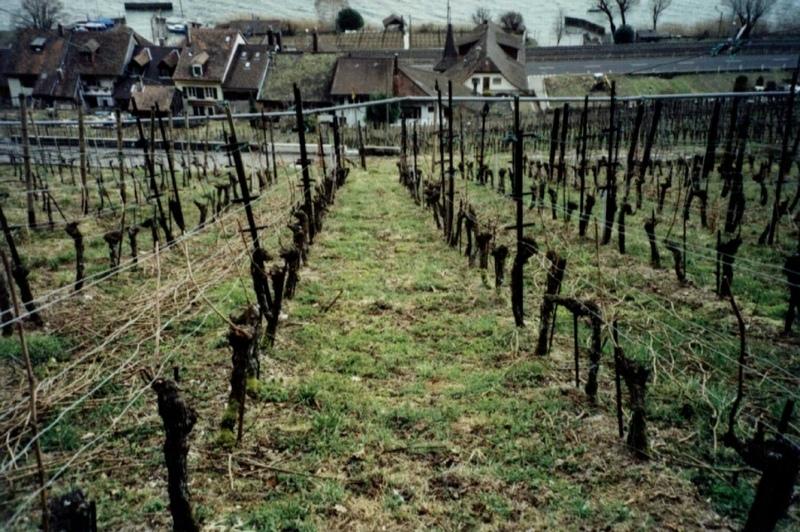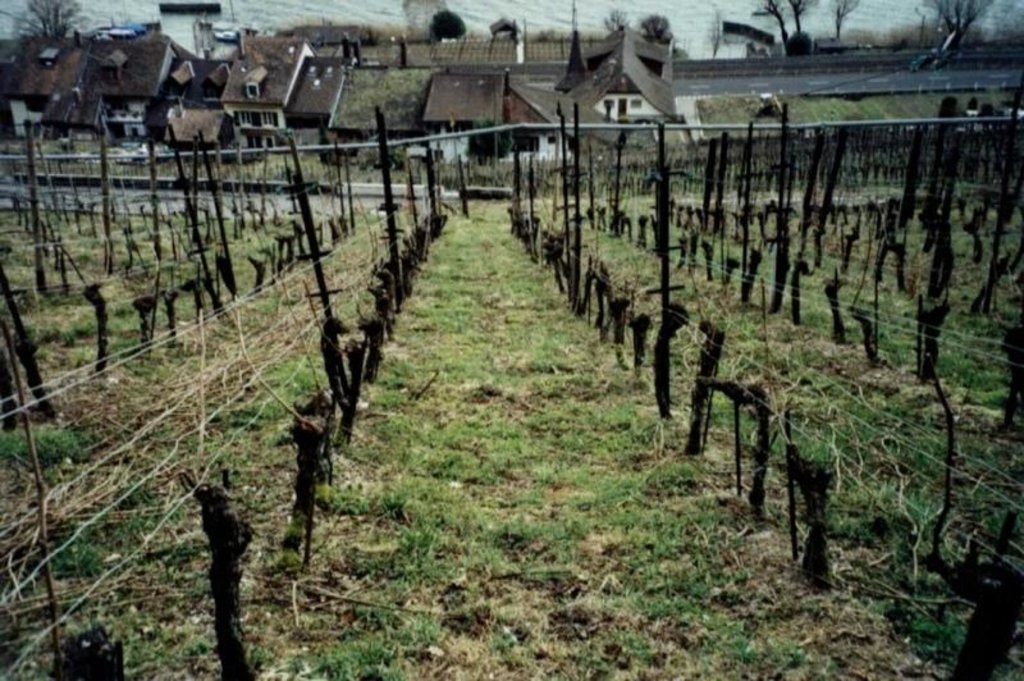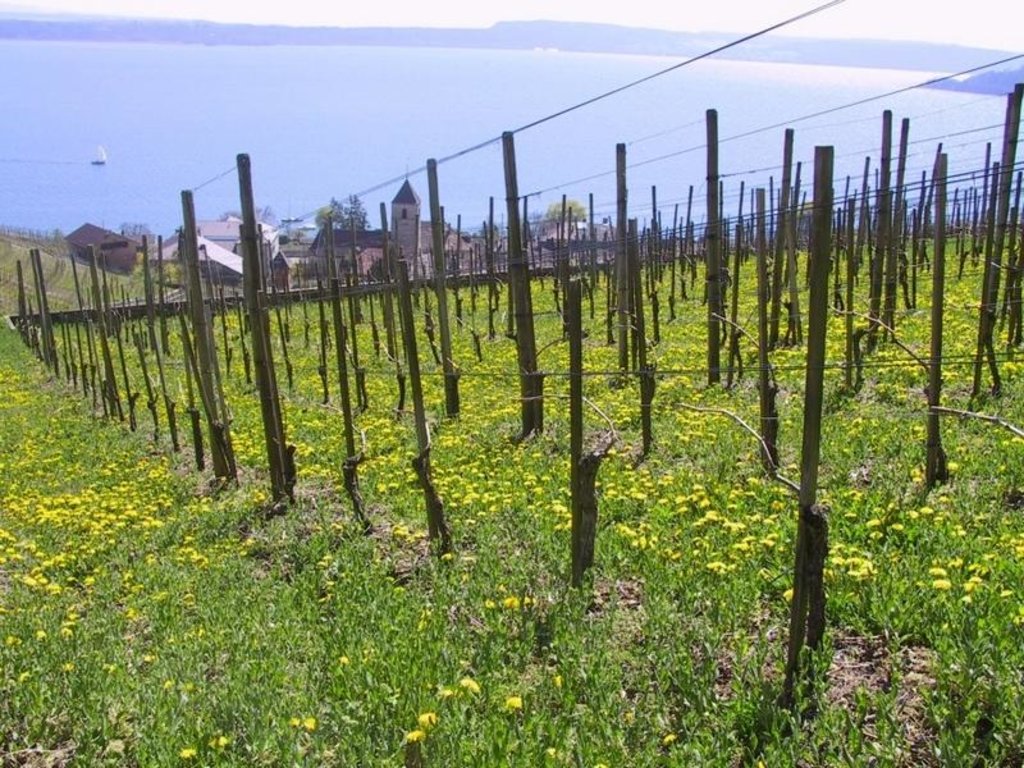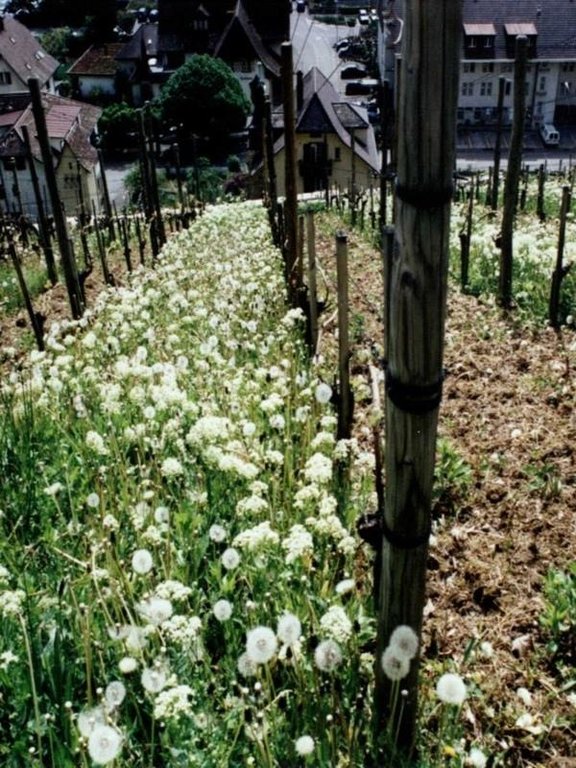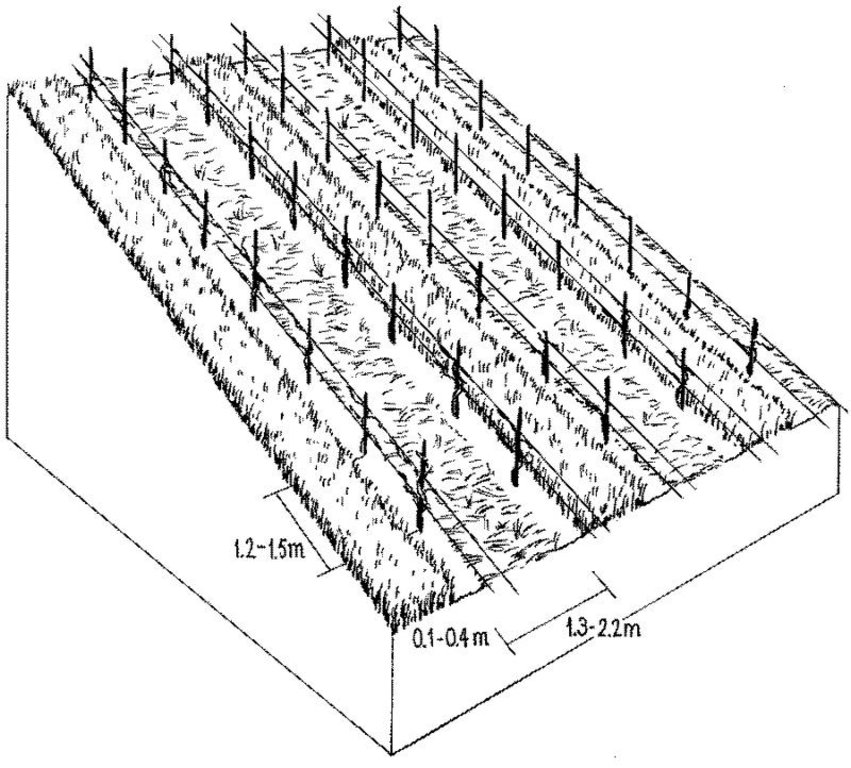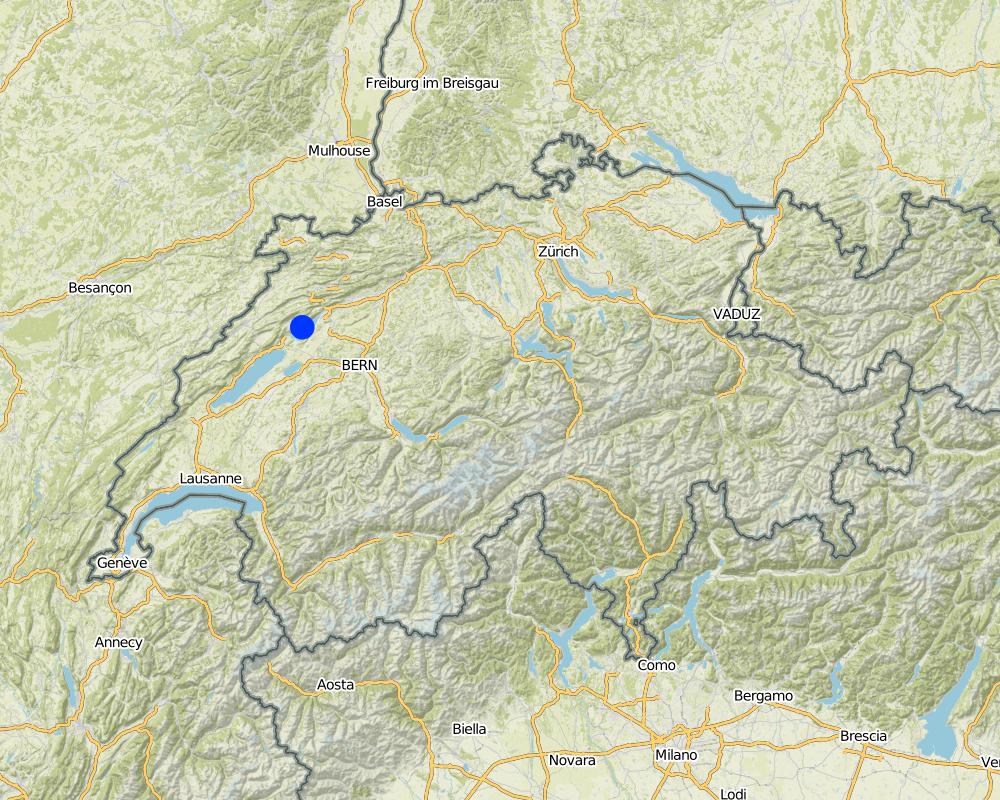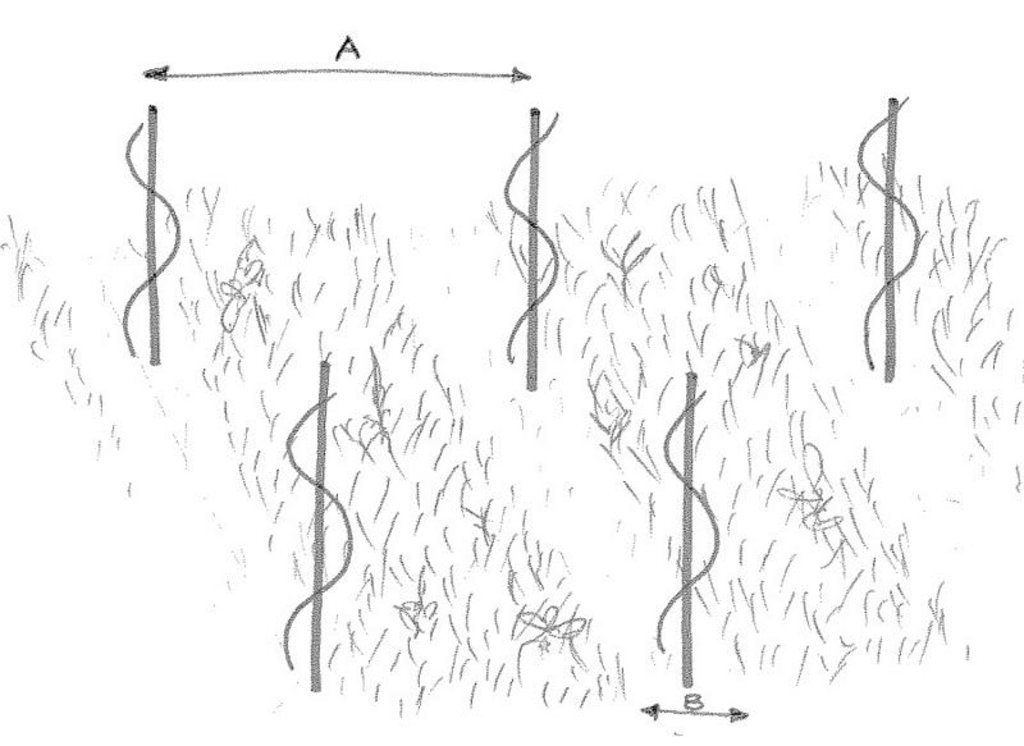Green cover in vineyards [Suiza]
- Creación:
- Actualización:
- Compilador: Nicole Guedel
- Editor: –
- Revisores: Fabian Ottiger, Deborah Niggli, Alexandra Gavilano
Begrünung von Rebflächen (im Direktzug / in der Falllinie bewirtschaftet)
technologies_1018 - Suiza
Visualizar secciones
Expandir todo Colapsar todos1. Información general
1.2 Detalles de contacto de las personas de referencia e instituciones involucradas en la evaluación y la documentación de la Tecnología
Especialista MST:
Weissenbach Peter
Federal Research Station for fruit-growing, viticulture and horticulture -FAW
Suiza
Especialista MST:
Spring Jean-Laurent
Federal Research Station for fruit-growing, viticulture and horticulture-RAC
Suiza
usuario de la tierra:
Louis Hannes
Louis Weinbau
Suiza
usuario de la tierra:
Hasler Lukas
Hasler Weinbau
Suiza
Nombre del proyecto que financió la documentación/ evaluación de la Tecnología (si fuera relevante)
Book project: where the land is greener - Case Studies and Analysis of Soil and Water Conservation Initiatives Worldwide (where the land is greener)Nombre de la(s) institución(es) que facilitaron la documentación/ evaluación de la Tecnología (si fuera relevante)
Federal Research Station for fruit-growing, viticulture and horticulture (FAW/RAC) - SuizaNombre de la(s) institución(es) que facilitaron la documentación/ evaluación de la Tecnología (si fuera relevante)
CDE Centre for Development and Environment (CDE Centre for Development and Environment) - Suiza1.3 Condiciones referidas al uso de datos documentados mediante WOCAT
El compilador y la/s persona(s) de referencia claves aceptan las condiciones acerca del uso de los datos documentados mediante WOCAT:
Sí
1.5 Referencia al (los) Cuestionario(s) de Enfoques MST (documentados usando WOCAT)
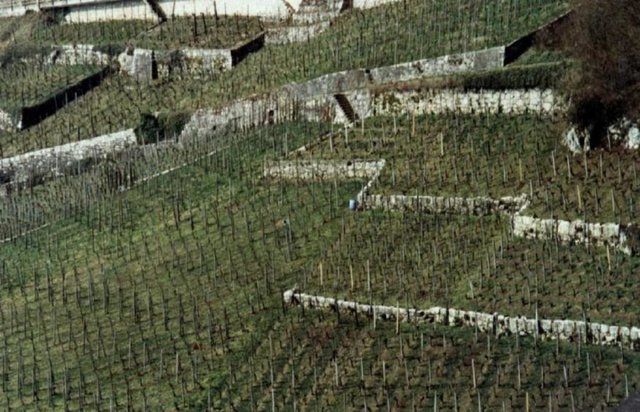
Farmer initiative within enabling environment [Suiza]
Initiative and innovation of land users, stimulated by government's technical and financial support.
- Compilador: Nicole Guedel
2. Descripción de la Tecnología MST
2.1 Breve descripción de la Tecnología
Definición de la Tecnología:
Naturally growing or sown perennial grasses/herbs providing cover
between rows in sloping vineyards, where the vines are usually oriented up and down slope.
2.2 Descripción detallada de la Tecnología
Descripción:
The area around Lake Biel has a strong wine growing tradition dating back several centuries. The vineyards are, for micro-climatic reasons, sited on the southwest facing slope close to the lake. Annual rainfall is about 1,000 mm, with at least one erosive storm per year, and the soils are highly erodible. In conventional viniculture all weeds are controlled chemically. The ‘green cover technology’ comprises sown, or naturally occurring, perennial grasses and herbs which form a biodiverse green cover - a ‘living mulch’ - over the soil surface between vine rows. In this region, rows are generally oriented up and down the slope for ease of machine operation. Green cover may also be applied where vines are grown on narrow bench terraces. The purpose is the prevention of soil degradation, especially soil erosion by water. Secondary purposes include protection of the soil surface from compaction when using mechanised equipment, and promotion of biodiversity.
Green cover is generally established naturally - except on contour-planted terraced vineyards, where cover is planted for immediate stabilisation of the terraces. To avoid competition, a 10-40 cm diameter zone around the freshly planted vines is kept free from vegetation: during the three year establishment period it is removed by hoe, later it is controlled with herbicides (either as a strip along vine rows or around individual vines). The topsoil between the vine rows is ripped every few years with an implement pulled by a small caterpillar tractor. The green cover vegetation is cut, chopped and left as mulch several times using special mulching machines. These operations are not carried out over the whole field at once: alternate rows are left untouched to ensure that some vegetation remains to maintain biodiversity. When these rows redevelop their green cover, the others are then treated. This is effectively a minimum tillage system, building up organic matter in the soil. Cutting and mulching, in addition to ripping, serves to circulate nutrients. Mineral fertilizer and herbicides are applied once a year around the vines. Experiments with the technology started in the 1970s, but green cover has now become standard practice.
Supportive measures include not removing crop residues (from vineyards) which are chopped later - simultaneously with the cover crop (grass) - to protect the soil surface, and irrigation in dry years.
2.3 Fotografías de la Tecnología
2.5 País/ región/ lugares donde la Tecnología fue aplicada y que se hallan comprendidos por esta evaluación
País:
Suiza
Región/ Estado/ Provincia:
Canton of Berne
Especifique más el lugar :
Lake of Biel
Comentarios:
The technology is applied in all wine growing regions of Switzerland, but under different conditions
Map
×2.6 Fecha de la implementación
Si no se conoce el año preciso, indique la fecha aproximada:
- hace menos de 10 años (recientemente)
2.7 Introducción de la Tecnología
Especifique cómo se introdujo la Tecnología:
- mediante proyectos/ intervenciones externas
Comentarios (tipo de proyecto, etc.):
The development of green cover in vineyards was (also on the international level) essentially promoted and supported by the Federal Research Station for fruit-growing, viticulture and horticulture in Wädenswil (Canton of Zürich)
3. Clasificación de la Tecnología MST
3.2 Tipo(s) actuales de uso de la tierra donde se aplica la Tecnología

Tierras cultivadas
- Cultivos perennes (no leñosos)
- Cosecha de árboles y arbustos
Cultivos de matorrales y arbustos - Especifique cultivos:
- uvas
Número de temporadas de cultivo por año:
- 1
Especifique:
Longest growing period in days: 210Longest growing period from month to month: Apr - Oct
Comentarios:
Major land use problems (compiler’s opinion): The main problem was decreasing soil fertility, especially through soil erosion by water, caused by lack of soil cover and intensive cultivation. There were associated negative offsite effects including sand/sediment deposition and contamination of groundwater by nutrients. This became a serious problem from the 1960s when the traditional labour-intensive methods were superseded by a mechanised-industrial agricultural system.
Type of cropping system and major crops comments: a vine plantation is established for a period of 20-40 years (lifetime of a vine). Some farmers make one year of fallow between the destruction of the old and the establishment of a new plantation.
3.4 Provisión de agua
Provisión de agua para la tierra donde se aplica la Tecnología:
- mixta de secano – irrigada
Comentarios:
Water supply: rainfed, mixed rainfed - irrigated
3.5 Grupo MST al que pertenece la Tecnología
- cobertura de suelo/ vegetal mejorada
- medida de pendiente transversal
3.6 Medidas MST que componen la Tecnología

medidas agronómicas
- A7: Otros

medidas vegetativas
- V5: Otros
Comentarios:
Main measures: agronomic measures, vegetative measures
Specification of other agronomic measures: minimum tillage: cutting & mulching, ripping
Specification of other vegetative measures: cover cropping
Type of agronomic measures: mulching, manure / compost / residues, mineral (inorganic) fertilizers, breaking compacted topsoil
Type of vegetative measures: scattered / dispersed
3.7 Principales tipos de degradación del suelo encarados con la Tecnología

erosión de suelos por agua
- Wt: pérdida de capa arable/ erosión de la superficie
- Wo: efectos de degradación fuera del sitio

deterioro químico del suelo
- Cn: reducción de la fertilidad y contenido reducido de la materia orgánica del suelo (no ocasionados por la erosión)
- Cp: contaminación del suelo

deterioro físico del suelo
- Pc: compactación
- Pk: desmoronamiento y encostramiento
Comentarios:
Main type of degradation addressed: Wt: loss of topsoil / surface erosion, Wo: offsite degradation effects, Cn: fertility decline and reduced organic matter content, Cp: soil pollution
Secondary types of degradation addressed: Pc: compaction, Pk: sealing and crusting
Main causes of degradation: other human induced causes (specify) (agricultural causes: fast changing basic conditions of viticulture in the last 100 years), education, access to knowledge and support services (lack of knowledge), fast changing basic conditions of viticulture (economy, laws)
3.8 Prevención, reducción o restauración de la degradación del suelo
Especifique la meta de la Tecnología con relación a la degradación de la tierra:
- reducir la degradación del suelo
Comentarios:
Main goals: mitigation / reduction of land degradation
4. Especificaciones técnicas, actividades de implementación, insumos y costos
4.1 Dibujo técnico de la Tecnología
Especificaciones técnicas (relacionadas al dibujo técnico):
Technical drawing of green cover on parcel with vine rows oriented up and down the slope. A = distance between vine rows (130-220 cm), B = zone of application of herbicides (10-40 cm).
Location: Twann, Lake of Biel. Canton of Berne
Date: June 2003
Technical knowledge required for field staff / advisors: moderate
Technical knowledge required for land users: moderate
Main technical functions: control of raindrop splash, control of dispersed runoff: retain / trap, improvement of ground cover, improvement of soil structure
Secondary technical functions: increase of surface roughness, increase in organic matter, increase of infiltration, increase / maintain water stored in soil, increase in soil fertility
Mulching
Material/ species: cut or chopped cover vegetation
Remarks: dispersed over the whole surface; if possible cutting/chopping only every second row (alternating)
Agronomic measure: removing less vegetation cover
Material/ species: cut or chopped cover vegetation, vine leaves and cut branches
Remarks: between vine rows
Manure / compost / residues
Material/ species: compost
Remarks: only sporadically (every 5-10 year or less)
Mineral (inorganic) fertilizers
Material/ species: nitrogen
Quantity/ density: 0-50 kg/ha
Remarks: normally rather little nitrogen
Agronomic measure: mineral (inorganic) fertilizers: potassium
Quantity/ density: 0-20 kg
Agronomic measure: mineral (inorganic) fertilizers: magnesium
Quantity/ density: 0-25 kg
Agronomic measure: mineral (inorganic) fertilizers: phosphorus
Quantity/ density: 0-20 kg
Breaking compacted topsoil
Remarks: if possible: only every second row (alternating)
Scattered / dispersed
Vegetative material: G : grass
Grass species: different grass species, taraxacum, veronica, legumes, calystegia, geranium...
Autor:
Nicole Güdel, Berne, Switzerland
4.2 Información general sobre el cálculo de insumos y costos
otra / moneda nacional (especifique):
Swiss Franc
Si fuera relevante, indique la tasa de cambio de dólares americanos a la moneda local (ej. 1 U$ = 79.9 Reales Brasileros): 1 U$ =:
0,75
4.3 Actividades de establecimiento
| Actividad | Momento (estación) | |
|---|---|---|
| 1. | Allow natural cover to establish. | winter/spring, usually at the same time as a new plantation is established |
| 2. | Weeding around base of vines to reduce competition, 2–4 times during | during season (Mai – October), 2 - 4 times, when necessary. |
4.4 Costos e insumos necesarios para el establecimiento
| Especifique insumo | Unidad | Cantidad | Costos por unidad | Costos totales por insumo | % de los costos cubiertos por los usuarios de las tierras | |
|---|---|---|---|---|---|---|
| Mano de obra | Labour | ha | 1,0 | 13800,0 | 13800,0 | 100,0 |
| Equipo | Machine use | ha | 1,0 | 1000,0 | 1000,0 | 100,0 |
| Equipo | Tools | ha | 1,0 | 100,0 | ||
| Material para plantas | Seeds of natural vegetation | ha | 1,0 | 100,0 | ||
| Fertilizantes y biocidas | Fertilizer | ha | 1,0 | 200,0 | 200,0 | 100,0 |
| Fertilizantes y biocidas | Biocides | ha | 1,0 | 100,0 | ||
| Fertilizantes y biocidas | Compost/manure | ha | 1,0 | 100,0 | ||
| Costos totales para establecer la Tecnología | 15000,0 | |||||
| Costos totales para establecer la Tecnología en USD | 20000,0 | |||||
Comentarios:
Duration of establishment phase: 36 month(s)
4.5 Actividades de establecimiento/ recurrentes
| Actividad | Momento/ frequencia | |
|---|---|---|
| 1. | cuting and not removing vine leaves and branches | winter / annual |
| 2. | Apply mineral fertilizer to the vines (particularly K, N, P, Mg) | April/May / annual |
| 3. | Cut cover vegetation with a portable motor scythe or mower with | during cropping season (first time April/May) / each row 2-4 times during cropping season |
| 4. | cuting and not removing vine leaves and branches | during cropping season / several times during cropping season |
| 5. | Minimum tillage (rip topsoil) of alternating inter-rows with machine | April/May / each row every 4-8 years |
| 6. | Application of herbicides (glyphosates) | beginning of season (May), if necessary second time in Aug./Sept /once (if necessary twice) during s |
| 7. | Cut/chop vine leaves and wood for mulching | during growing season, 2-4 times |
4.6 Costos e insumos necesarios para actividades de mantenimiento/ recurrentes (por año)
| Especifique insumo | Unidad | Cantidad | Costos por unidad | Costos totales por insumo | % de los costos cubiertos por los usuarios de las tierras | |
|---|---|---|---|---|---|---|
| Mano de obra | Labour | ha | 1,0 | 1500,0 | 1500,0 | 100,0 |
| Equipo | Machine use | ha | 1,0 | 650,0 | 650,0 | 100,0 |
| Equipo | Tools | ha | 1,0 | 100,0 | ||
| Fertilizantes y biocidas | Fertilizer | ha | 1,0 | 60,0 | 60,0 | 100,0 |
| Fertilizantes y biocidas | Biocides | ha | 1,0 | 90,0 | 90,0 | 100,0 |
| Fertilizantes y biocidas | Compost/manure | ha | 1,0 | 100,0 | ||
| Indique los costos totales para mantenecer la Tecnología | 2300,0 | |||||
| Costos totales para mantener la Tecnología en USD | 3066,67 | |||||
Comentarios:
Machinery/ tools: e.g.: hoe, mower with tracked vehicle or portable motor scythe, spading machine with tracked vehicle; knapsack sprayer or biocide tank transported by
Costs are calculated on the basis of vine rows being oriented up and down the slope, a distance between rows of
1.3-2.2 m and 6,500 vines per ha on a slope of <60%. Establishment costs have been estimated and are representative of the situation when green cover is encouraged to establish at the same time as new vines are planted (normal practice). This means that the estimated costs include all the annual agronomic and vegetative inputs within the first 3 years during the establishment phase. If green cover is implemented more than 3 years after planting new vines, establishment costs are much reduced, because the vines are bigger, competition with the green cover is less, and the vines are not so sensitive to herbicides, which permits the replacement of labour intensive manual weeding by application of herbicides. Maintenance costs are based on one typical winegrower in the region. Initial investments in machinery and costs directly attributable to ‘plant capital’ (the vines) are not included.
4.7 Factores más determinantes que afectan los costos:
Describa los factores más determinantes que afectan los costos:
Labour is the major cost component, since wage levels are very high in Switzerland.
5. Entorno natural y humano
5.1 Clima
Lluvia anual
- < 250 mm
- 251-500 mm
- 501-750 mm
- 751-1,000 mm
- 1,001-1,500 mm
- 1,501-2,000 mm
- 2,001-3,000 mm
- 3,001-4,000 mm
- > 4,000 mm
Especificaciones/ comentarios sobre la cantidad de lluvia:
Average: Biel: 1200 mm. Region of Bielersee: 1000 - 1200 mm. Neuchâtel: 930 mm.
Zona agroclimática
- Sub-húmeda
Thermal climate class: temperate
5.2 Topografía
Pendientes en promedio:
- plana (0-2 %)
- ligera (3-5%)
- moderada (6-10%)
- ondulada (11-15%)
- accidentada (16-30%)
- empinada (31-60%)
- muy empinada (>60%)
Formaciones telúricas:
- meseta/ planicies
- cordilleras
- laderas montañosas
- laderas de cerro
- pies de monte
- fondo del valle
Zona altitudinal:
- 0-100 m s.n.m.
- 101-500 m s.n.m.
- 501-1,000 m s.n.m
- 1,001-1,500 m s.n.m
- 1,501-2,000 m s.n.m
- 2,001-2,500 m s.n.m
- 2,501-3,000 m s.n.m
- 3,001-4,000 m s.n.m
- > 4,000 m s.n.m
Comentarios y especificaciones adicionales sobre topografía :
Altitudinal zones: 501-1000 m a.s.l. (For climatic reasons vines grow hardly above 600 m a.s.l. in Switzerland )
Landforms: Hill slopes (most of them southeastward sloping hills (part of the Jura mountain range) )
5.3 Suelos
Profundidad promedio del suelo:
- muy superficial (0-20 cm)
- superficial (21-50 cm)
- moderadamente profunda (51-80 cm)
- profunda (81-120 cm)
- muy profunda (>120 cm)
Textura del suelo (capa arable):
- mediana (limosa)
Materia orgánica de capa arable:
- media (1-3%)
Si se halla disponible, adjunte una descripción completa de los suelos o especifique la información disponible, por ej., tipo de suelo, pH/ acidez de suelo, capacidad de intercambio catiónico, nitrógeno, salinidad, etc. :
Soil depth on average: Deep (81-120cm) (Soil depth is very irregular, at some places limestone rocks appear at the surface, at other places soil can be quite deep).
Soil fertility is medium (Vines are normally grown on rather marginal spots. Compared to the general productivity these soils have a medium fertility. (If measured at the vine itself, soil fertility is sufficient/high).
Topsoil organic matter is medium (1-3%) (without / before SWC (green cover)
Soil drainage/infiltration is mostly good, at some points medium (at some spots medium (depressions; when high percentage of clay).
Soil water storage capacity is medium (without / before SWC (green cover)), high (without / before SWC (green cover)) or low (without / before SWC (green cover). Depressions; when high percentage of clay)
5.6 Las características de los usuarios de la tierra que aplican la Tecnología
Orientación del mercado del sistema de producción:
- comercial/ mercado
Ingresos no agrarios:
- menos del 10% de todos los ingresos
Nivel relativo de riqueza:
- promedio
Nivel de mecanización:
- trabajo manual
- mecanizado/motorizado
Indique otras características relevantes de los usuarios de las tierras:
Population density: 200-500 persons/km2
Annual population growth: 0.5% - 1%
100% of the land users are average wealthy.
Off-farm income specification: This is representative for the full time winegrowers. The majority of winegrowers do winegrowing beside a regular off-farm job (partly 10-50% of income with salary from off-farm work) as a hobby. Nearly all winegrowers have implementeted the SWC technology. Probably there is no difference in hobby-winegrowers and full-time-winegrowers concernring implementation of the SWC technology.
Level of mechanization is manual labour (most of the work in the vineyard is done by hand (especially harvest)) or mechanised (some of the activities are carried out with fuel driven equipment. But mechanisation is moderate since big and heavy machines cannot been applied in these vineyards)
Market orientation is: Commercial/market (in the region of the lake of Biel the majority of grapes are pressed to wine an then and sold directly from the farm's wine cellar)
5.7 Área promedio de la tierra usada por usuarios de tierra que aplican la Tecnología
- < 0.5 ha
- 0.5-1 ha
- 1-2 ha
- 2-5 ha
- 5-15 ha
- 15-50 ha
- 50-100 ha
- 100-500 ha
- 500-1,000 ha
- 1,000-10,000 ha
- > 10,000 ha
Comentarios:
Average area of land owned or leased by land users applying the Technology: 0.5-1 ha, 1-2 ha, 2-5 ha (only winegrowing land!)
5.8 Tenencia de tierra, uso de tierra y derechos de uso de agua
Tenencia de tierra:
- individual, con título
Derechos de uso de tierra:
- arrendamiento
- individual
6. Impactos y comentarios para concluir
6.1 Impactos in situ demostrados por la Tecnología
Impactos socioeconómicos
Producción
producción de cultivo
Comentarios/ especifique:
10–20% due to competition for water/nutrients
calidad de cultivo
Comentarios/ especifique:
Quality of wine decreased when strong competition of water and nutrients happens and nothing is done against it.
riesgo de fracaso de producción
Comentarios/ especifique:
Due to competition of water and nutrients and higher susceptibility to fungal decay (due to higher evapotranspiration rate with green cover and therefore humid microclimatic conditions). Little danger of frost only in depressions or plains (due to higher evapotranspiration rate)
Ingreso y costos
ingreso agrario
Comentarios/ especifique:
(Indirectly due to less erosion damage in the long-term – also due to subsidies related to green cover,marketing under the label of ‘ecological agricultural production’, and other criteria)
carga de trabajo
Comentarios/ especifique:
More and specific knowledge necessary. Weeing, cutting, ripping
Otros impactos socioeconómicos
Machine use
Comentarios/ especifique:
Special machines needed, mechanisation is almost a must to be economically successful in the long term
Impactos socioculturales
situación de salud
Comentarios/ especifique:
Healthier than without SWC, less application of biocides
instituciones comunitarias
Comentarios/ especifique:
Increased exchange of knowledge and contacts in winegrowers society
instituciones nacionales
Comentarios/ especifique:
Research stations gained new knowledge and attention
MST/ conocimiento de la degradación del suelo
Comentarios/ especifique:
Among winegrowers, but perhaps also slightly among consumers (through an ecological marketing argument) or walkers (walking through a green vineyard may arise interest in green cover).
mitigación de conflicto
Comentarios/ especifique:
Between generations or between farmers applying green cover and others. Reason: farmers are differently attached to traditional values and norms (i.e.: traditionally every plant 'out-of-place' was seen as unuseful weed and fought with a hoe)
Personal satisfaction / challenge
Comentarios/ especifique:
Many farmers apply green cover see green cover as a personal satisfaction or challenge for an ecologically and economically sustainable viticulture
Acceptance by society
Comentarios/ especifique:
Landscape and appearance of vineyard as cultural heritage. Reason: different values an norms of "how a vineyard should look like". Traditionally vines were planted very dense with no vegetation cover in between.
Impactos ecológicos
Suelo
humedad del suelo
Comentarios/ especifique:
Especially through improved water retention capacity (due to improved soil structure)
cubierta del suelo
pérdida de suelo
compactación de suelo
Biodiversidad: vegetación, animales
especies invasoras extrañas
Comentarios/ especifique:
Especially mice
control de pestes/ enfermedades
Comentarios/ especifique:
Through beneficial animals
Otros impactos ecológicos
Soil fertility
Biodiversity
Soil erosion through wind
6.2 Impactos fuera del sitio demostrados por la Tecnología
inundaciones río abajo
colmatación río abajo
Comentarios/ especifique:
And groundwater
contaminación de aguas subterráneas/ de ríos
sedimentos transportados por el viento
6.4 Análisis costo-beneficio
¿Cómo se comparan los beneficios con los costos de establecimiento (desde la perspectiva de los usuarios de tierra)?
Ingresos a corto plazo:
negativo
Ingresos a largo plazo:
positivo
¿Cómo se comparan los beneficios con los costos de mantenimiento/ recurrentes (desde la perspectiva de los usuarios de tierra)?
Ingresos a corto plazo:
positivo
Ingresos a largo plazo:
positivo
6.5 Adopción de la Tecnología
De todos quienes adoptaron la Tecnología, ¿cuántos lo hicieron espontáneamente, por ej. sin recibir nada de incentivos/ materiales:
- 91-100%
Comentarios:
10% of land user families have adopted the Technology with external material support
Comments on acceptance with external material support: estimates
90% of land user families have adopted the Technology without any external material support
Comments on spontaneous adoption: estimates
There is a strong trend towards spontaneous adoption of the Technology
Comments on adoption trend: Nearly all of the land users have adopted green cover independently of the direct incentives received for growing vines. The spontaneous spread of green cover occurred before these incentives were tied to ‘ecological production’. Note: Swiss agriculture in general is highly subsidised (see approach).
6.7 Fuerzas/ ventajas/ oportunidades de la Tecnología
| Fuerzas/ ventajas/ oportunidades desde la perspectiva del usuario de la tierra |
|---|
|
Personal satisfaction/challenge for ecologically and economically sustainable viniculture How can they be sustained / enhanced? Promote ecologically sustainable agriculture. |
|
Increased exchange of knowledge and contacts in winegrowers’ associations How can they be sustained / enhanced? Sustain/strengthen farmers’ institutions. |
| Improved knowledge/awareness regarding SWC/erosion: among winegrowers, but perhaps also to some extent among consumers (through ecological marketing) or walkers passing by. |
| Fuerzas/ ventajas/ oportunidades desde la perspectiva del compilador o de otra persona de referencia clave |
|---|
|
Prevention of erosion How can they be sustained / enhanced? Maintain green cover |
|
Improvement of soil quality (fertility, organic matter, moisture retention, soil structure) How can they be sustained / enhanced? Ensure that cover vegetation doesn’t compete with the vines; improve soil properties by applying mentioned agronomic measures. |
|
Contribution to a better balanced and more stable ecosystem (with living space for a wider range of organisms) How can they be sustained / enhanced? Specific management of cover crops (alternating treatment of inter-rows; find solutions to replace application of herbicide). |
| In the long-term economically beneficial because of cutting costs of restoration of soils and fertility loss after heavy erosion events. |
| Possibilities of farm income increase through marketing wine under the ‘vinatura’ label, certifying ecologically produced wine. |
6.8 Debilidades/ desventajas/ riesgos de la Tecnología y formas de sobreponerse a ellos
| Debilidades/ desventajas/ riesgos desde la perspectiva del compilador o de otra persona de referencia clave | ¿Cómo sobreponerse a ellas? |
|---|---|
| General competition of water and nutrients depending on climate, soil depth and species of cover vegetation | Eliminate/reduce competitive effect of cover vegetation by cutting/mulching vegetation or ripping/ploughing soil. |
| Application of herbicides around vines because of undesirable vegetation in proximity of vine | Find alternative solutions, or minimise application of herbicides. |
7. Referencias y vínculos
7.1 Métodos/ fuentes de información
Vínculos y módulos
Expandir todo Colapsar todosVínculos

Farmer initiative within enabling environment [Suiza]
Initiative and innovation of land users, stimulated by government's technical and financial support.
- Compilador: Nicole Guedel
Módulos
No se hallaron módulos


